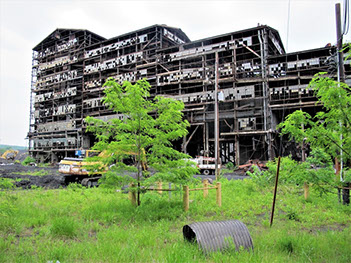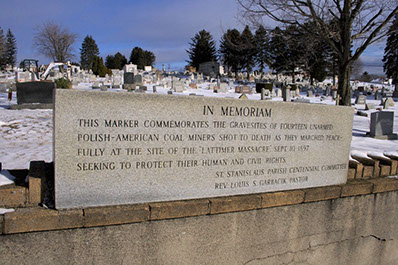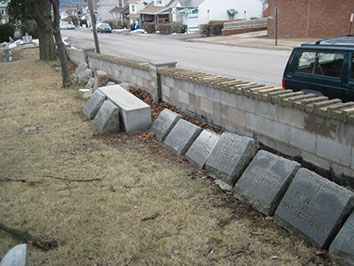
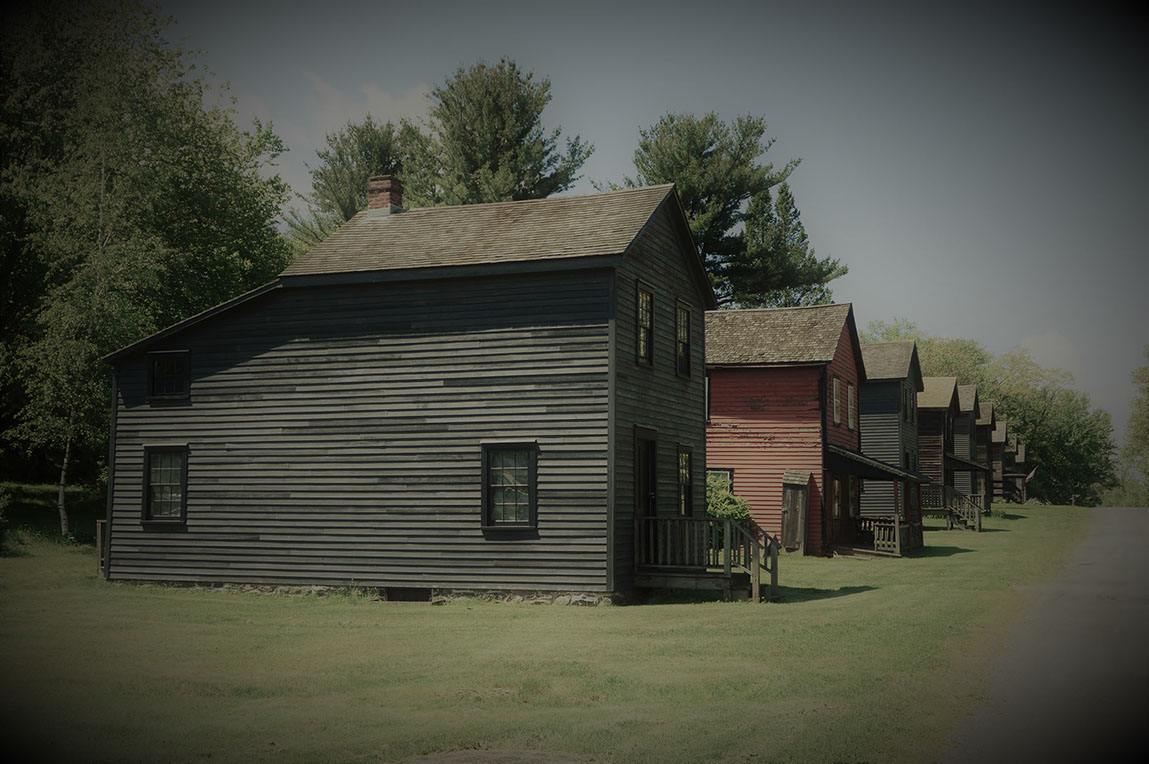
Week Six 7/3/017-7/7/2017
Our Final Week in the Field
By: Paul Shackel
Every year we meet more people and make new friends while working in Northeastern Pennsylvania and it’s sad to say good bye for another year. The field school students did professional work by developing field drawing of the Band House as well as plans and photographs of the nearly 170 outbuildings in Eckley Miners’ Village (Figure 1). We did a shovel test survey of one of the former miners’ homes and placed three excavation units in the backyard. The archaeology in this backyard was intact and has the potential to answer questions about life and poverty in this coal mining community. All of the artifacts have been cleaned, labeled and catalogued. The vessel analysis is about to begin.
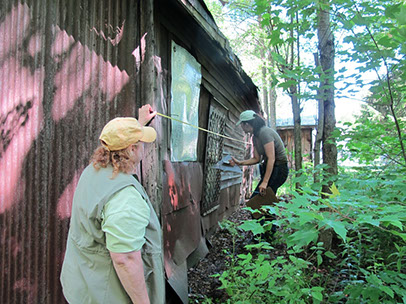
Photo Courtesy of Paul Shackel.
Fig. 1 Crew members Anne LoDico and Kyla Cools surveying the band house.
This year, much like the past, we heard about the struggles of the miners who labored in sometimes brutal conditions and we learned how families survived on near starvation wages. Once-a-week we were visited by Joe Michel a former resident of Eckley. During our lunchtime he told us stories about growing up in Eckley #5 – a community with two houses, and single water pump. While some children played marbles, he hauled and cracked coal for the family. There were stories about family and stories about making ends meet (Figure 2).
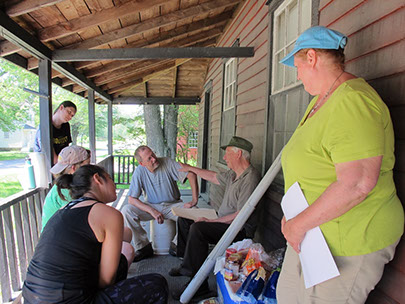
Related Resources
Press & Publications
About
Us
Blogs
Eckley Archaeology Blog - Summer 2017
Photo Courtesy of Paul Shackel.
Fig. 2 Joe Michel with the crew at lunch discussing the history of Eckley.
We also learned about life in the Anthracite with fieldtrips the Anthracite Museum and the Lackawanna Coal tour in Scranton, as well as a field trip to examine several reclamation projects. We toured Mahanoy City and read about the Molly Maguires (Figure 3), and viewed the dismantling of the St. Nicholas Breaker (Figure 4). The train ride at the Ashland mine provided a spectacular view of the valley and we saw the beginning of wind power development in the region (Figure 5). The trip to Centralia left a haunting feeling about the destruction of communities and landscapes resulting from the pursuit of profit.
Photo Courtesy of Paul Shackel
Fig. 3 Molly Maguire statue in Mahanoy City.
Photo Courtesy of Paul Shackel
Fig. 4 Dismantling of the St. Nicholas breaker.

Photo Courtesy of Paul Shackel
Fig. 5 A view at the end of rail line at the Ashland mines showing how wind turbines are making a faint appearance in the Anthracite region.
We had a chance to visit the Lattimer, the site of one of the most fatal labor tragedies in US history. The massacre site is marked by a commemorative stone. We also went to St. Stanislaus cemetery and saw the grave markers of those killed at Lattimer. In 1997, a stone memorial marker with an inscription commemorating the Lattimer massacre victims was placed on the cemetery wall facing Arthur Street (Figure 6). About three years ago, during the reconstruction of the cemetery wall, the marker was placed on the ground inside of the cemetery with the inscription facing the wall (Figure 7). It is no longer visible from the street and the inscription cannot be viewed from inside the cemetery. Every year I return to the cemetery thinking that someone, or some organization will place the marker where it was originally intended to be situated, on top of the wall with the inscription in public view - facing the street. While there is a long history of the coal miners in the Anthracite region being exploited and having a history that is not fully represented in the national public memory, the absence of this marker only makes it more difficult to recognize their history and remember the sacrifice of the coal workers in this region.
Photo Courtesy of Paul Shackel
Fig. 6 Commemorative marker facing Arthur St, January 2010.
Photo Courtesy of Paul Shackel
Fig. 7 The commemorative marker behind the cemetery wall is no longer visible on Arthur St. and the inscription is not easily readable from inside of the cemetery wall. It displaces two of the markers associated with the Lattimer martyrs (April 2017).
Week Five 6/26/2017-6/30/2017
Into the Lab: Many Hands Make Light Work!
By: Katie Boyle
We’ve covered a lot of ground since Week 1, with the documentation of the Band House, the outbuilding survey, and the excavations on Property #114. Week 5 of the field school found us wrapping up our 3 test units in the field and transitioning into the lab.
Photo courtesy of Katie Boyle
Students and volunteers hard at work in the lab!
Excavation is only a part of what archaeologists do. For every hour in the field, about three hours are spent taking care of the artifacts in the lab, which prepares them for further study. As the artifacts were collected from Property #114, they were taken into the lab, where they were checked in, cleaned, labeled, and cataloged. Analyzing these artifacts lets us better interpret and understand the site, and maybe learn more about the people who lived there. Aside from glass, ceramics, and nails, we’ve had some more interesting finds, including part of a cat figurine and quite a few marbles!
Photo courtesy of Kyla Cools
Cat figurine head after it was excavated.
Thanks to our field school students, high school students, and volunteers (and even the Professors!), we were able to process most of our artifacts before the 4th of July break!
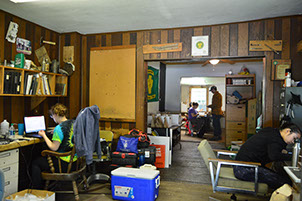

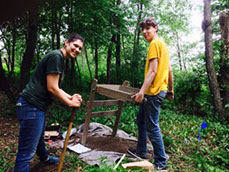
Photo courtesy of Anne LoDico.
Crew member Dolly Canevari working with high school volunteer Gabriel M.
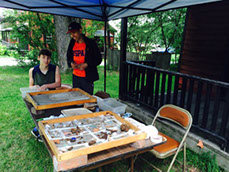
Photo courtesy of Anne LoDico.
High school volunteers Gabriel M. and Cesar D. manning the table at Patchtown Days.
Week Four 6/19/2017-6/23/2017
Public Archaeology & Outreach Methods
By: Anne LoDico
It's been a very exciting week at the field school as we were joined by volunteer students from a local High School in Hazleton, Pennsylvania. It is a wonderful opportunity for the students to learn the importance of preserving the history of the coal miners and their families in Northeastern Pennsylvania.
The week began with the staff and students working together on more than 60 shovel tests pits that were marked by Dr. Paul Shackel, Dr. Don Linebaugh, Kyla Cools, and Katie Boyle. The shovel test pits are an important archaeological technique that is used to discover and locate areas that are worth investigating in the early parts of the excavation. The site at Eckley Miners’ Village was selected on a property that had several outbuildings that were in good condition; additionally, there was a foundation located behind the house that once belonged to a summer kitchen. In the summer months, it was too hot for cooking inside the house so the kitchen was moved to a structure that was then set up as the summer kitchen.
Another highlight of the week was Patchtown Days, which is a celebration of the thousands of immigrants that came to work in the Anthracite coal mining region of Northeastern Pennsylvania. It was a wonderful weekend as spectators gathered to see various events, including an 1860s baseball game. The players were dressed in the uniforms of the 1860s and played by the rules of the 1860s. The field school was represented in a parade down Main Street on Saturday afternoon.
People stopped by the archaeology lab to see the hundreds of artifacts excavated and learn about what the field school has been doing this summer. Some stopped by to share their stories of their relatives who worked in the local coal mines. They were happy to see the work being done by the field school to remember the past.
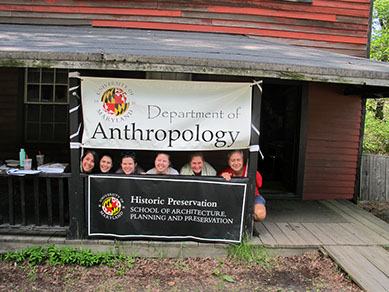
Photo courtesy of Paul Shackel.
Crew members pose for a photo with banners for the UMD Anthropology Department and the Historic Preservation Department.
Pictured (from left to right): Kyla Cools, Dolly Canevari, Katie Boyle, Callie Fishburn, Anne LoDico, and Paul Shackel.

Photo courtesy of Katie Boyle.
Crew member Dolly Canevari sketching an outbuilding in the field!
Surveying Outbuildings
By: Dolly Canevari
Our second week in Eckley Miners' Village focused on the historic preservation of different outbuildings. The goal of documenting and preserving the architecture was to understand how the residents of Eckley used their space. Many of the homes int he patch town were built by the coal company, but some of the outbuildings were built by the residents of the houses themselves. We started the week with a goal of documenting 60 outbuildings, however, at the end of this part of the project the team doumented a total of 167 outbuildings. We looked at structures built from the 1860s up through the late 1900s, and the buildings ranged from coal sheds to garages. Some of the buildings were made out of scraps of whatever the residents had on hand-coal grates were placed as window screens, cardboard boxes lined the walls as insulation, and chicken coops were concocted from the leftover wood of dynamite boxes.
While our documentation of the different outbuildings noted the different architectural features including different exterior claddings, rooftops and floorplans, we finished a detailed architectural documentation of Eckley's band house. We captured the building through multiple floor plans, interior drawings, recording the elevations and noting the different structural materials. The small room, used for a community brass band, was a space for the miners and laborers to come together. A former teaching assistant of this project found a newspaper article announcing the construction of the band house in 1890. And although the small building was dilapidated, small features brought the building to life. You could imagine band uniforms placed on the row of hooks at the back of the room or the boisterous sound of brass ricocheting off of the sheet metal covering the walls.
Week Two 6/5/2017-6/9/2017
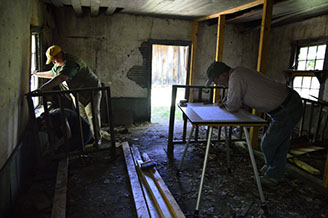
Photo courtesy of Katie Boyle.
Crew members Kyla Cools, Anne Lodico, and Don Linebaugh work on documenting the interior of the band house!
Figure 2: Hercules Powder Company explosives box.
Figure 1: Hercules Powder Company Advertisement from the Mining and Scientific Press, 1893.
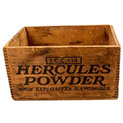
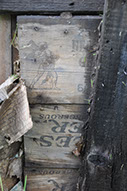
Photo courtesy of Don Linebaugh.
Figure 3: Parts of a Hercules Powder Company explosives box used to line the summer kitchen, Outbuilding #99 (note the Hercules trademark).
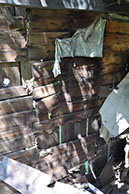
Week Three 6/12/2017-6/16/2017
Explosive Discovery While Surveying Eckley’s Vernacular Outbuildings!
By: Don Linebaugh
The UMD archaeology and preservation field school recently spent two great weeks surveying and documenting the domestic outbuildings at Eckley Miners’ Village. Our initial estimate suggested we would document about 75 structures, so imagine our surprise when we finished at Outbuilding #166! The buildings included a wide range of types including summer kitchens, privies, chicken houses, coal houses, storage sheds, and garages that supported the company owned homes of the town’s laborers and miners.
Most of these outbuildings were constructed by the residents, as the company only built the summer kitchens and some privies. Thus, we find that these structures are a mishmash of reused, borrowed, stolen, and recycled materials that were available to the residents. One particularly interesting discovery was the use of wooden dynamite boxes to line the interiors of some of the structures, particularly the summer kitchens. The buildings are typically a vertical plank and light frame construction, often without the use of exterior battens to cover the spaces between the vertical planks. Residents apparently winterized these buildings by covering the interior walls with newspaper, cardboard, wallpaper, or whatever was at hand and then tacked up the dynamite box parts over this rudimentary insulation. The semi-ruinous summer kitchen (Outbuilding #99) at one of the two-story double houses near the center of town, displays this interior wall covering using box parts marked “Hercules Powder.”
The Hercules Powder Company was initially formed in 1882 by DuPont and Laflin & Rand Powder Company to finance construction of a dynamite plant on land owned by a DuPont subsidiary known as the California Powder Works. The firm was reformed as a separate company and incorporated in Wilmington, Delaware, in 1912 as a result of the breakup of the E.I. du Pont de Nemours "powder trust." As a separate company, it continued to produce explosives and dynamite, before expanding into the production of chemicals and munitions for the World Wars. A company advertisement (Figure 1) indicates that Hercules had plants up and down the East Coast including one in Hazelton.
The wooden Hercules boxes (Figure 2) would have been ubiquitous in mining patch towns like Eckley and were the perfect material to line the walls of outbuildings, sturdy wood parts (Figure 3) that were all the same thickness with finger joints at the corner that could be connected to form a relatively solid wall surface (Figure 4). Even better, they were free!
The domestic outbuildings of Eckley are important survivals that speak to the residents’ initiative and resourcefulness in building structures needed to support and enhance their daily lives.

Figure 4: Interior wall of summer kitchen (Outbuilding #99) showing the use of explosive/dynamite boxes used as a covering.
Week One 5/29/2017-6/2/2017
Meet the Summer 2017 Field Crew!
By: Kyla Cools
Photo courtesy of Mike Korb
The Field Crew and staff from Eckley Miners' Village receiving a tour of abandoned mine reclamations in progress from Department of Environmental Protection members, Mike Korb and Larry Dobash.
Pictured left to right: Larry Dobash, Anne LoDico, Kyla Cools, Katie Boyle, Bode Morin, Dolly Canevari, Paul Shackel, Don Linebaugh, and Emily Arcaro.
As we begin a new field season, we bring new objectives and a new crew! Taking a different approach this year, the field school is incorporating a focus on historic preservation in addition to our archaeological work this summer. This means we are not only performing excavations at Eckley Miners’ Village, we are also documenting a variety of buildings such as the band house and outbuildings (these include summer kitchens, outhouses, sheds, garages, etc.) along Main Street. Thanks to the dedication of our field crew-made up of professors, students, and volunteers-we hope to make this summer one to remember! Read on for a brief introduction to our crew members and some highlights from our first week out in NEPA!
Dr. Paul Shackel is a professor of Anthropology at the University of Maryland, College Park. Creating the Anthracite Heritage Program in 2009, Dr. Shackel has been bringing university students out to NEPA to help explore and document the history of the anthracite region for close to a decade. Teaching students interdisciplinary methods such as collecting oral histories, performing archival research, and archaeological excavations, Dr. Shackel has been helping to provide a material dimension to understanding historic and contemporary issues related to work, labor, gender, and immigration in the anthracite region.
Dr. Don Linebaugh is a professor of Historic Preservation at the University of Maryland, College Park. Joining the Anthracite Heritage Program in 2016, Dr. Linebaugh is helping to teach students how to document and preserve the industrial heritage of the the anthracite region. Prior to joining the University of Maryland in 2004, Dr. Linebaugh served as the Director of the Program for Archaeological Research (PAR) and a Professor of Anthropology at the University of Kentucky.
Kyla Cools is a doctoral student in the Anthropology Department at the University of Maryland, College Park. Specializing in historical archaeology and museum scholarship, Kyla is working to better understand the historic impact of injury and physical disability in industrial labor of the 19th and 20th century. Kyla graduated with a B.A. in Anthropology from Michigan State University.
Katie Boyle is a dual masters student with the Anthropology and Historic Preservation Departments at the University of Maryland, College Park. Focusing on the use of outdoor spaces, Katie is applying her skills towards digitally mapping and preserving 19th and 20th century industrial labor sites. Katie graduated with a B.A. in Anthropology from St. Mary’s College of Maryland.
Anne LoDico is a student at Stockton University majoring in Anthropology. Anne is interested in studying the impact of immigration on indigenous populations and subsequent cultural evolution. She is also interested in learning more about the forced process of cultural assimilation on indigenous children through boarding schools.
Dolly Canevari is a recent graduate of the University of Rochester with a B.A. in Cultural Anthropology and a B.M. in Applied Music Performance. Dolly will be entering law school in Fall 2018 with an emphasis on public interests, and is interested the historic impact of poverty and the facets of its continuation over time.
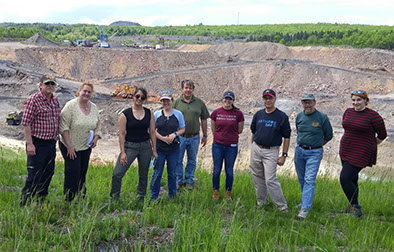
Sponsored by the University of Maryland Department of Anthropology
1111 Woods Hall, College Park, MD 20742
(c) 2015 V.C. Westmont
Contact us with feedback, questions, or concerns

